Importance of Strategic Quality and System Management
VerifiedAdded on 2020/10/22
|9
|2403
|462
AI Summary
The assignment discusses the importance of strategic quality and system management in an organization's structure and strategy. It explores different approaches to quality management, including administrative systems that support all activities related to quality management. The report concludes that effective administrative systems can result in efficient quality management and minimize employee turnover.
Contribute Materials
Your contribution can guide someone’s learning journey. Share your
documents today.
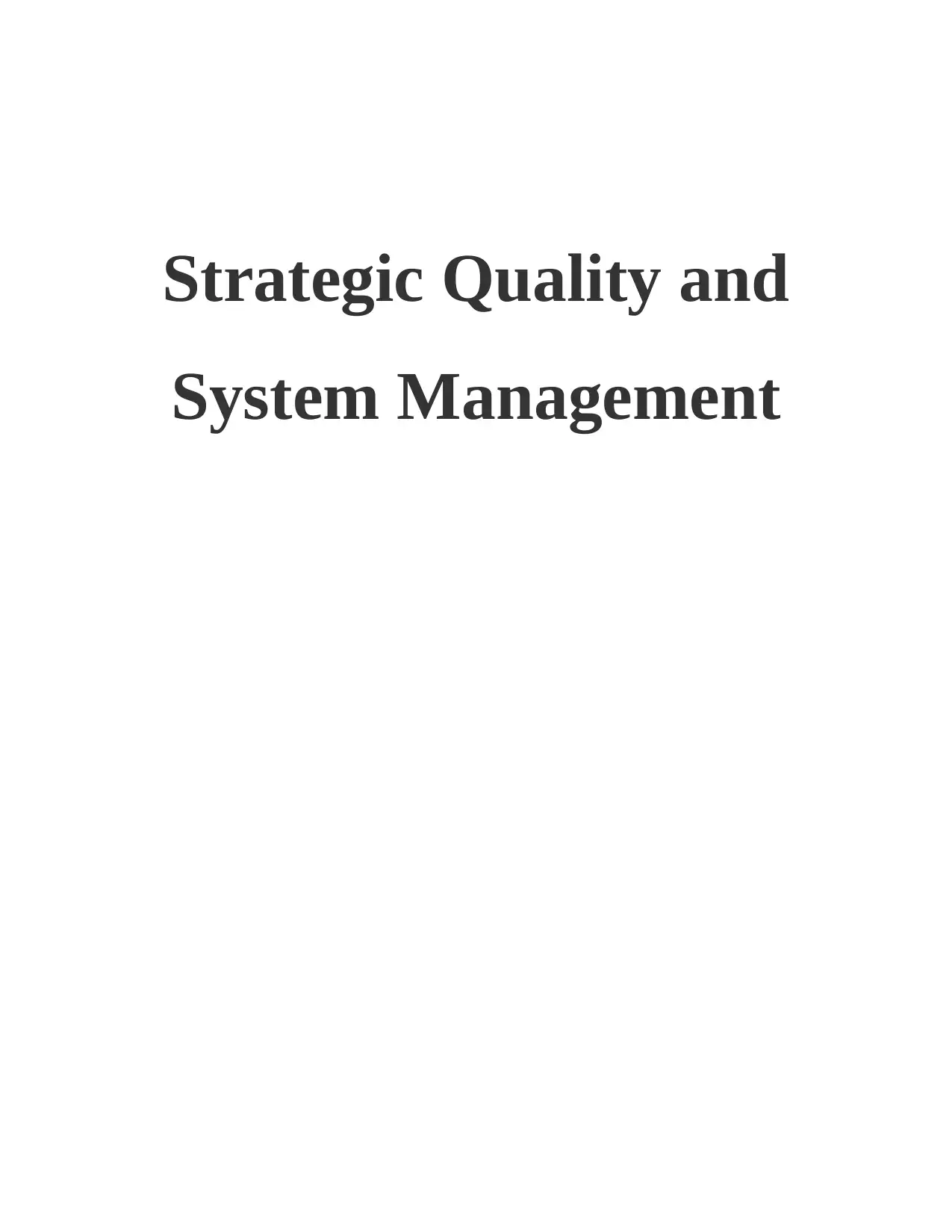
Strategic Quality and
System Management
System Management
Secure Best Marks with AI Grader
Need help grading? Try our AI Grader for instant feedback on your assignments.
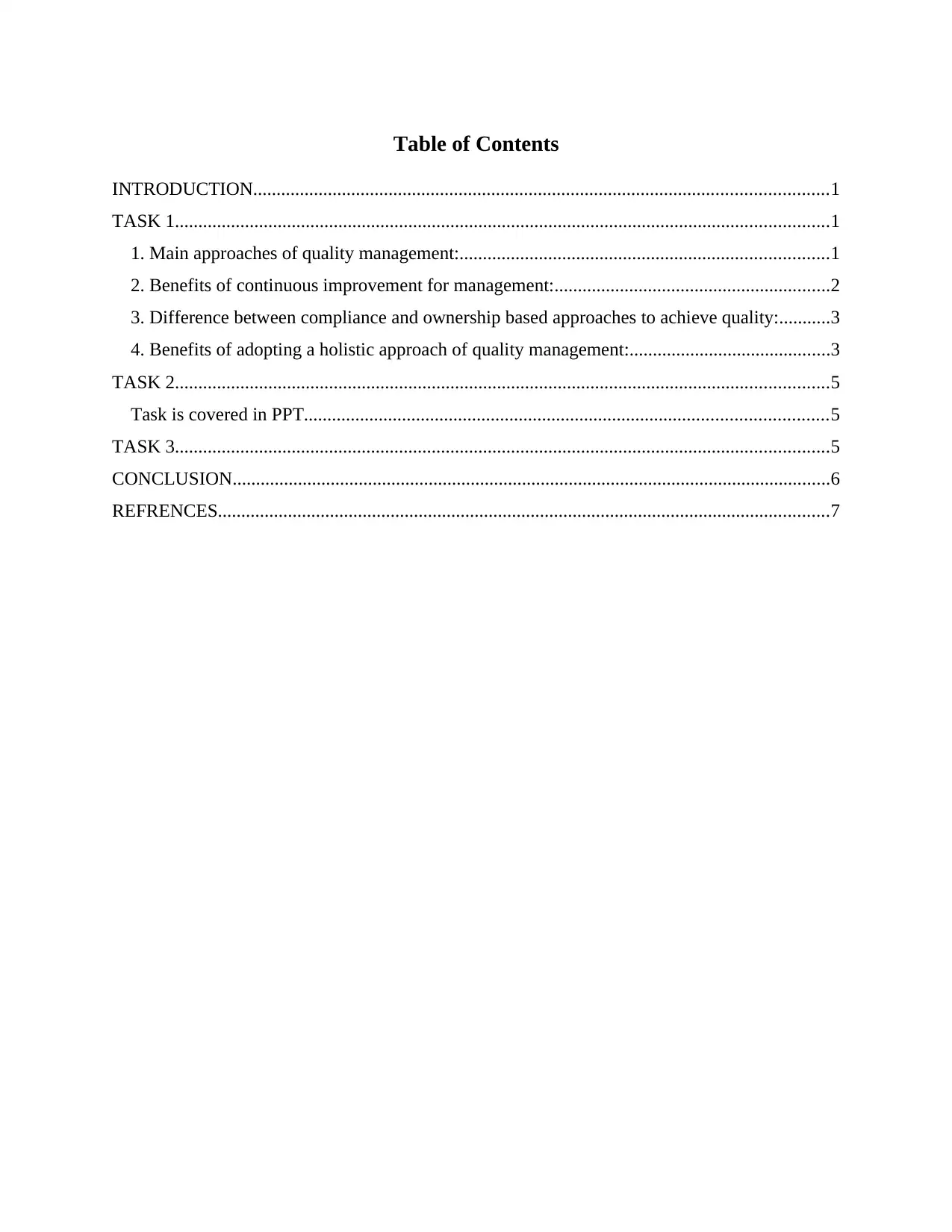
Table of Contents
INTRODUCTION...........................................................................................................................1
TASK 1............................................................................................................................................1
1. Main approaches of quality management:...............................................................................1
2. Benefits of continuous improvement for management:...........................................................2
3. Difference between compliance and ownership based approaches to achieve quality:...........3
4. Benefits of adopting a holistic approach of quality management:...........................................3
TASK 2............................................................................................................................................5
Task is covered in PPT................................................................................................................5
TASK 3............................................................................................................................................5
CONCLUSION................................................................................................................................6
REFRENCES...................................................................................................................................7
INTRODUCTION...........................................................................................................................1
TASK 1............................................................................................................................................1
1. Main approaches of quality management:...............................................................................1
2. Benefits of continuous improvement for management:...........................................................2
3. Difference between compliance and ownership based approaches to achieve quality:...........3
4. Benefits of adopting a holistic approach of quality management:...........................................3
TASK 2............................................................................................................................................5
Task is covered in PPT................................................................................................................5
TASK 3............................................................................................................................................5
CONCLUSION................................................................................................................................6
REFRENCES...................................................................................................................................7
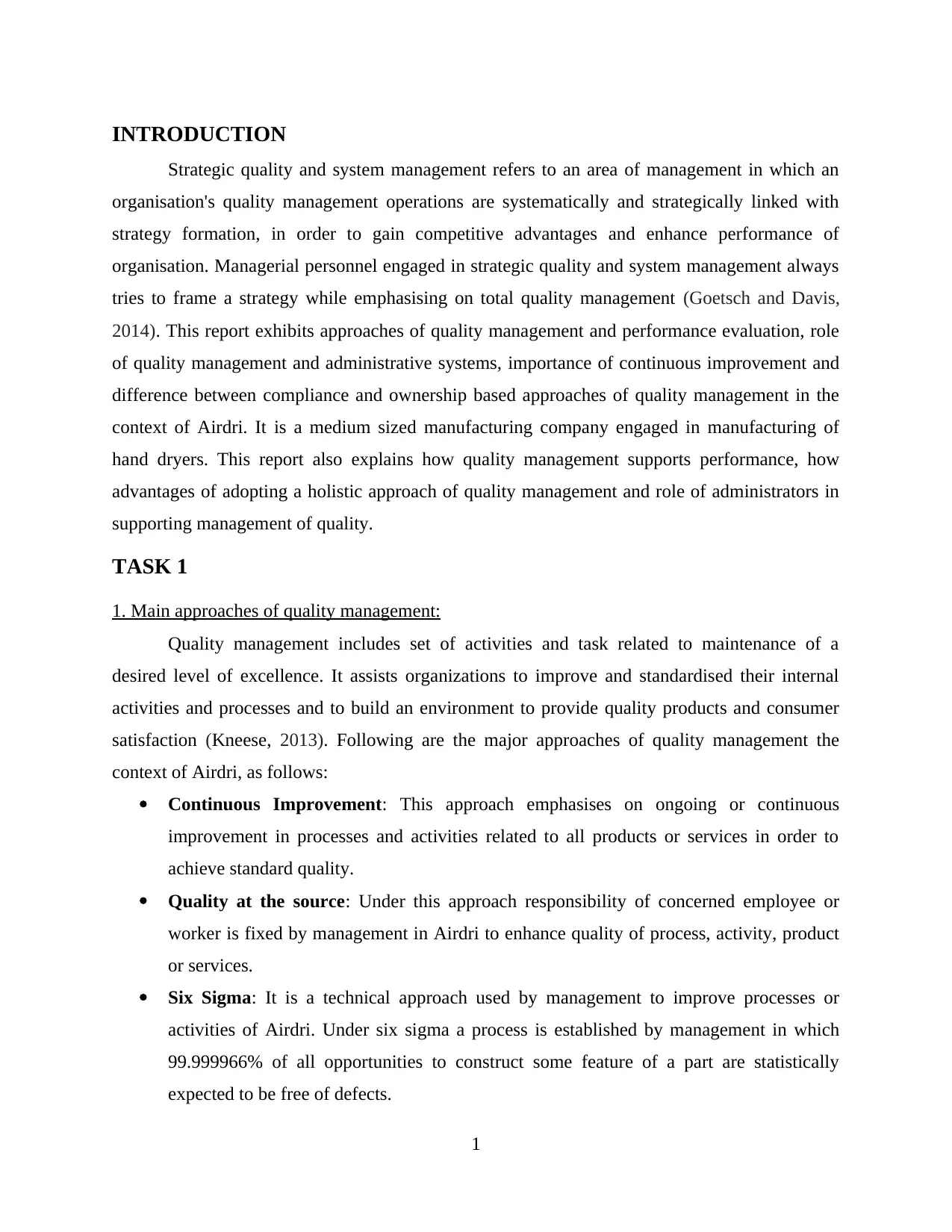
INTRODUCTION
Strategic quality and system management refers to an area of management in which an
organisation's quality management operations are systematically and strategically linked with
strategy formation, in order to gain competitive advantages and enhance performance of
organisation. Managerial personnel engaged in strategic quality and system management always
tries to frame a strategy while emphasising on total quality management (Goetsch and Davis,
2014). This report exhibits approaches of quality management and performance evaluation, role
of quality management and administrative systems, importance of continuous improvement and
difference between compliance and ownership based approaches of quality management in the
context of Airdri. It is a medium sized manufacturing company engaged in manufacturing of
hand dryers. This report also explains how quality management supports performance, how
advantages of adopting a holistic approach of quality management and role of administrators in
supporting management of quality.
TASK 1
1. Main approaches of quality management:
Quality management includes set of activities and task related to maintenance of a
desired level of excellence. It assists organizations to improve and standardised their internal
activities and processes and to build an environment to provide quality products and consumer
satisfaction (Kneese, 2013). Following are the major approaches of quality management the
context of Airdri, as follows:
Continuous Improvement: This approach emphasises on ongoing or continuous
improvement in processes and activities related to all products or services in order to
achieve standard quality.
Quality at the source: Under this approach responsibility of concerned employee or
worker is fixed by management in Airdri to enhance quality of process, activity, product
or services.
Six Sigma: It is a technical approach used by management to improve processes or
activities of Airdri. Under six sigma a process is established by management in which
99.999966% of all opportunities to construct some feature of a part are statistically
expected to be free of defects.
1
Strategic quality and system management refers to an area of management in which an
organisation's quality management operations are systematically and strategically linked with
strategy formation, in order to gain competitive advantages and enhance performance of
organisation. Managerial personnel engaged in strategic quality and system management always
tries to frame a strategy while emphasising on total quality management (Goetsch and Davis,
2014). This report exhibits approaches of quality management and performance evaluation, role
of quality management and administrative systems, importance of continuous improvement and
difference between compliance and ownership based approaches of quality management in the
context of Airdri. It is a medium sized manufacturing company engaged in manufacturing of
hand dryers. This report also explains how quality management supports performance, how
advantages of adopting a holistic approach of quality management and role of administrators in
supporting management of quality.
TASK 1
1. Main approaches of quality management:
Quality management includes set of activities and task related to maintenance of a
desired level of excellence. It assists organizations to improve and standardised their internal
activities and processes and to build an environment to provide quality products and consumer
satisfaction (Kneese, 2013). Following are the major approaches of quality management the
context of Airdri, as follows:
Continuous Improvement: This approach emphasises on ongoing or continuous
improvement in processes and activities related to all products or services in order to
achieve standard quality.
Quality at the source: Under this approach responsibility of concerned employee or
worker is fixed by management in Airdri to enhance quality of process, activity, product
or services.
Six Sigma: It is a technical approach used by management to improve processes or
activities of Airdri. Under six sigma a process is established by management in which
99.999966% of all opportunities to construct some feature of a part are statistically
expected to be free of defects.
1
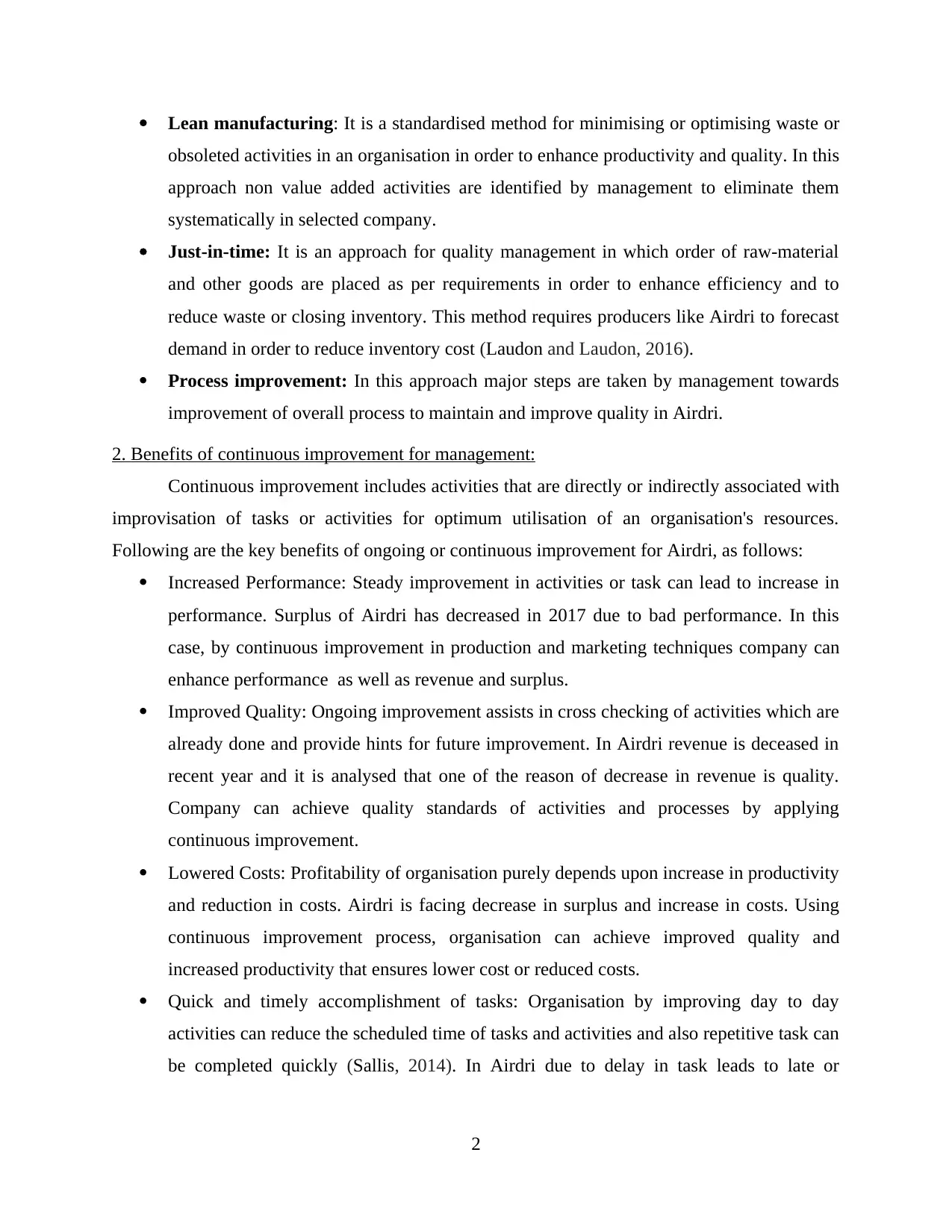
Lean manufacturing: It is a standardised method for minimising or optimising waste or
obsoleted activities in an organisation in order to enhance productivity and quality. In this
approach non value added activities are identified by management to eliminate them
systematically in selected company.
Just-in-time: It is an approach for quality management in which order of raw-material
and other goods are placed as per requirements in order to enhance efficiency and to
reduce waste or closing inventory. This method requires producers like Airdri to forecast
demand in order to reduce inventory cost (Laudon and Laudon, 2016).
Process improvement: In this approach major steps are taken by management towards
improvement of overall process to maintain and improve quality in Airdri.
2. Benefits of continuous improvement for management:
Continuous improvement includes activities that are directly or indirectly associated with
improvisation of tasks or activities for optimum utilisation of an organisation's resources.
Following are the key benefits of ongoing or continuous improvement for Airdri, as follows:
Increased Performance: Steady improvement in activities or task can lead to increase in
performance. Surplus of Airdri has decreased in 2017 due to bad performance. In this
case, by continuous improvement in production and marketing techniques company can
enhance performance as well as revenue and surplus.
Improved Quality: Ongoing improvement assists in cross checking of activities which are
already done and provide hints for future improvement. In Airdri revenue is deceased in
recent year and it is analysed that one of the reason of decrease in revenue is quality.
Company can achieve quality standards of activities and processes by applying
continuous improvement.
Lowered Costs: Profitability of organisation purely depends upon increase in productivity
and reduction in costs. Airdri is facing decrease in surplus and increase in costs. Using
continuous improvement process, organisation can achieve improved quality and
increased productivity that ensures lower cost or reduced costs.
Quick and timely accomplishment of tasks: Organisation by improving day to day
activities can reduce the scheduled time of tasks and activities and also repetitive task can
be completed quickly (Sallis, 2014). In Airdri due to delay in task leads to late or
2
obsoleted activities in an organisation in order to enhance productivity and quality. In this
approach non value added activities are identified by management to eliminate them
systematically in selected company.
Just-in-time: It is an approach for quality management in which order of raw-material
and other goods are placed as per requirements in order to enhance efficiency and to
reduce waste or closing inventory. This method requires producers like Airdri to forecast
demand in order to reduce inventory cost (Laudon and Laudon, 2016).
Process improvement: In this approach major steps are taken by management towards
improvement of overall process to maintain and improve quality in Airdri.
2. Benefits of continuous improvement for management:
Continuous improvement includes activities that are directly or indirectly associated with
improvisation of tasks or activities for optimum utilisation of an organisation's resources.
Following are the key benefits of ongoing or continuous improvement for Airdri, as follows:
Increased Performance: Steady improvement in activities or task can lead to increase in
performance. Surplus of Airdri has decreased in 2017 due to bad performance. In this
case, by continuous improvement in production and marketing techniques company can
enhance performance as well as revenue and surplus.
Improved Quality: Ongoing improvement assists in cross checking of activities which are
already done and provide hints for future improvement. In Airdri revenue is deceased in
recent year and it is analysed that one of the reason of decrease in revenue is quality.
Company can achieve quality standards of activities and processes by applying
continuous improvement.
Lowered Costs: Profitability of organisation purely depends upon increase in productivity
and reduction in costs. Airdri is facing decrease in surplus and increase in costs. Using
continuous improvement process, organisation can achieve improved quality and
increased productivity that ensures lower cost or reduced costs.
Quick and timely accomplishment of tasks: Organisation by improving day to day
activities can reduce the scheduled time of tasks and activities and also repetitive task can
be completed quickly (Sallis, 2014). In Airdri due to delay in task leads to late or
2
Secure Best Marks with AI Grader
Need help grading? Try our AI Grader for instant feedback on your assignments.
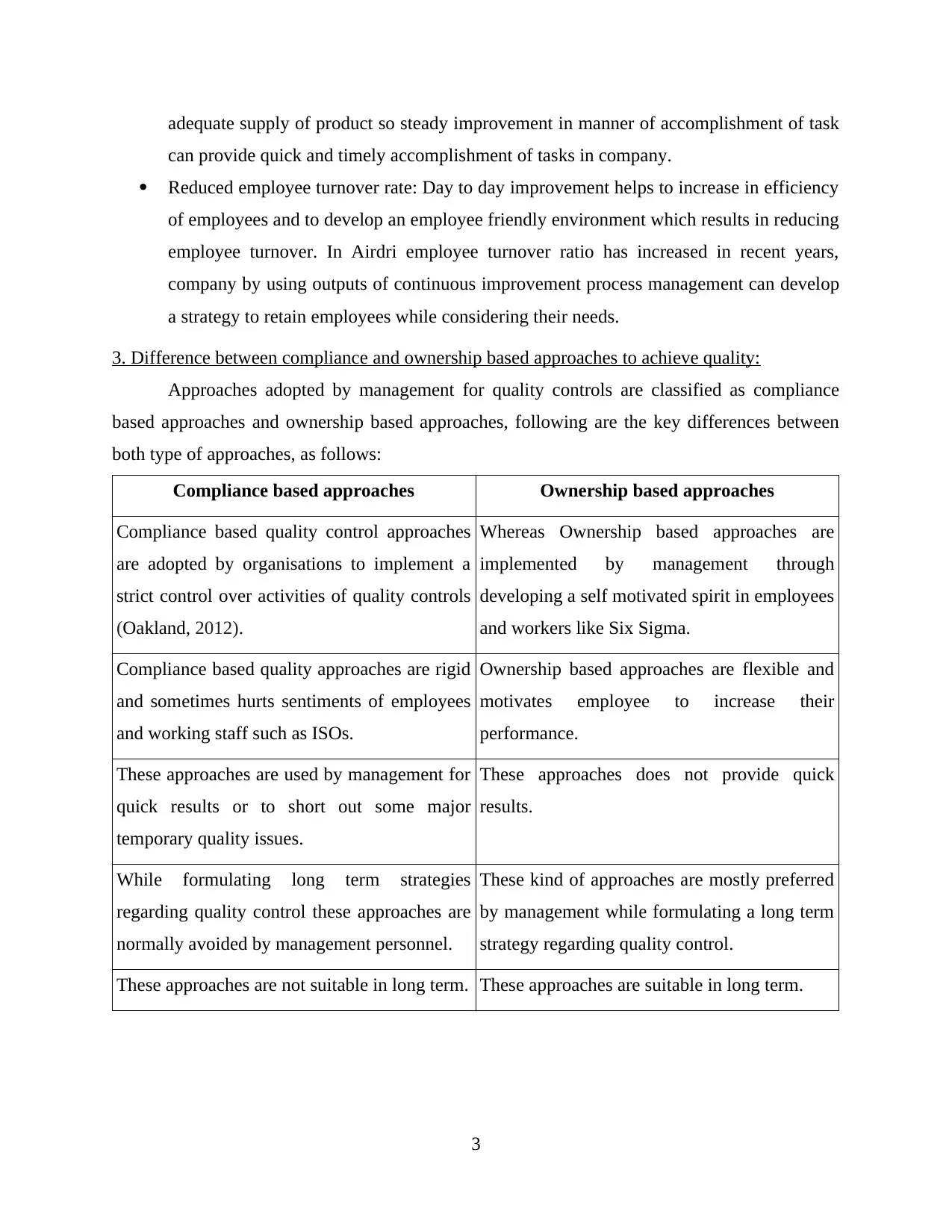
adequate supply of product so steady improvement in manner of accomplishment of task
can provide quick and timely accomplishment of tasks in company.
Reduced employee turnover rate: Day to day improvement helps to increase in efficiency
of employees and to develop an employee friendly environment which results in reducing
employee turnover. In Airdri employee turnover ratio has increased in recent years,
company by using outputs of continuous improvement process management can develop
a strategy to retain employees while considering their needs.
3. Difference between compliance and ownership based approaches to achieve quality:
Approaches adopted by management for quality controls are classified as compliance
based approaches and ownership based approaches, following are the key differences between
both type of approaches, as follows:
Compliance based approaches Ownership based approaches
Compliance based quality control approaches
are adopted by organisations to implement a
strict control over activities of quality controls
(Oakland, 2012).
Whereas Ownership based approaches are
implemented by management through
developing a self motivated spirit in employees
and workers like Six Sigma.
Compliance based quality approaches are rigid
and sometimes hurts sentiments of employees
and working staff such as ISOs.
Ownership based approaches are flexible and
motivates employee to increase their
performance.
These approaches are used by management for
quick results or to short out some major
temporary quality issues.
These approaches does not provide quick
results.
While formulating long term strategies
regarding quality control these approaches are
normally avoided by management personnel.
These kind of approaches are mostly preferred
by management while formulating a long term
strategy regarding quality control.
These approaches are not suitable in long term. These approaches are suitable in long term.
3
can provide quick and timely accomplishment of tasks in company.
Reduced employee turnover rate: Day to day improvement helps to increase in efficiency
of employees and to develop an employee friendly environment which results in reducing
employee turnover. In Airdri employee turnover ratio has increased in recent years,
company by using outputs of continuous improvement process management can develop
a strategy to retain employees while considering their needs.
3. Difference between compliance and ownership based approaches to achieve quality:
Approaches adopted by management for quality controls are classified as compliance
based approaches and ownership based approaches, following are the key differences between
both type of approaches, as follows:
Compliance based approaches Ownership based approaches
Compliance based quality control approaches
are adopted by organisations to implement a
strict control over activities of quality controls
(Oakland, 2012).
Whereas Ownership based approaches are
implemented by management through
developing a self motivated spirit in employees
and workers like Six Sigma.
Compliance based quality approaches are rigid
and sometimes hurts sentiments of employees
and working staff such as ISOs.
Ownership based approaches are flexible and
motivates employee to increase their
performance.
These approaches are used by management for
quick results or to short out some major
temporary quality issues.
These approaches does not provide quick
results.
While formulating long term strategies
regarding quality control these approaches are
normally avoided by management personnel.
These kind of approaches are mostly preferred
by management while formulating a long term
strategy regarding quality control.
These approaches are not suitable in long term. These approaches are suitable in long term.
3
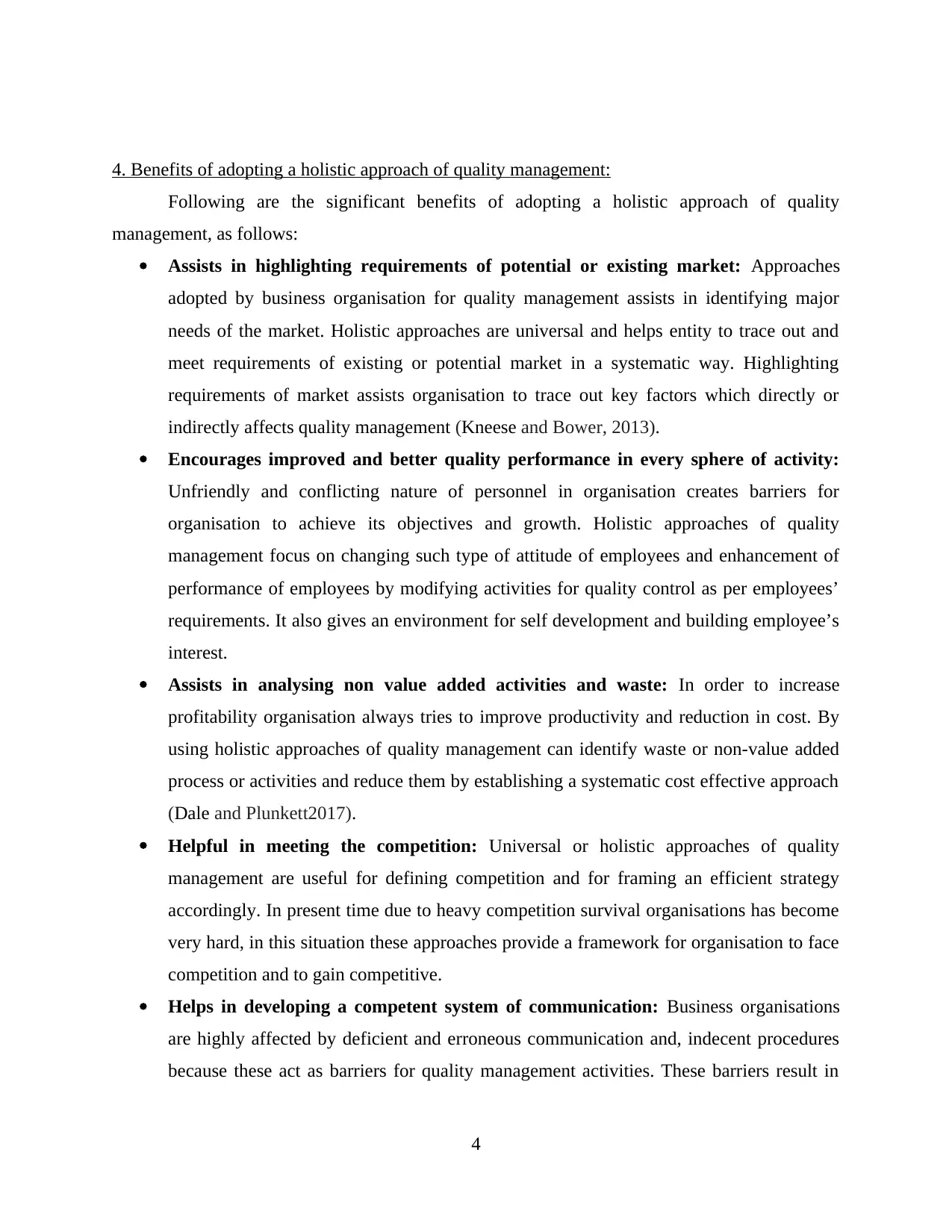
4. Benefits of adopting a holistic approach of quality management:
Following are the significant benefits of adopting a holistic approach of quality
management, as follows:
Assists in highlighting requirements of potential or existing market: Approaches
adopted by business organisation for quality management assists in identifying major
needs of the market. Holistic approaches are universal and helps entity to trace out and
meet requirements of existing or potential market in a systematic way. Highlighting
requirements of market assists organisation to trace out key factors which directly or
indirectly affects quality management (Kneese and Bower, 2013).
Encourages improved and better quality performance in every sphere of activity:
Unfriendly and conflicting nature of personnel in organisation creates barriers for
organisation to achieve its objectives and growth. Holistic approaches of quality
management focus on changing such type of attitude of employees and enhancement of
performance of employees by modifying activities for quality control as per employees’
requirements. It also gives an environment for self development and building employee’s
interest.
Assists in analysing non value added activities and waste: In order to increase
profitability organisation always tries to improve productivity and reduction in cost. By
using holistic approaches of quality management can identify waste or non-value added
process or activities and reduce them by establishing a systematic cost effective approach
(Dale and Plunkett2017).
Helpful in meeting the competition: Universal or holistic approaches of quality
management are useful for defining competition and for framing an efficient strategy
accordingly. In present time due to heavy competition survival organisations has become
very hard, in this situation these approaches provide a framework for organisation to face
competition and to gain competitive.
Helps in developing a competent system of communication: Business organisations
are highly affected by deficient and erroneous communication and, indecent procedures
because these act as barriers for quality management activities. These barriers result in
4
Following are the significant benefits of adopting a holistic approach of quality
management, as follows:
Assists in highlighting requirements of potential or existing market: Approaches
adopted by business organisation for quality management assists in identifying major
needs of the market. Holistic approaches are universal and helps entity to trace out and
meet requirements of existing or potential market in a systematic way. Highlighting
requirements of market assists organisation to trace out key factors which directly or
indirectly affects quality management (Kneese and Bower, 2013).
Encourages improved and better quality performance in every sphere of activity:
Unfriendly and conflicting nature of personnel in organisation creates barriers for
organisation to achieve its objectives and growth. Holistic approaches of quality
management focus on changing such type of attitude of employees and enhancement of
performance of employees by modifying activities for quality control as per employees’
requirements. It also gives an environment for self development and building employee’s
interest.
Assists in analysing non value added activities and waste: In order to increase
profitability organisation always tries to improve productivity and reduction in cost. By
using holistic approaches of quality management can identify waste or non-value added
process or activities and reduce them by establishing a systematic cost effective approach
(Dale and Plunkett2017).
Helpful in meeting the competition: Universal or holistic approaches of quality
management are useful for defining competition and for framing an efficient strategy
accordingly. In present time due to heavy competition survival organisations has become
very hard, in this situation these approaches provide a framework for organisation to face
competition and to gain competitive.
Helps in developing a competent system of communication: Business organisations
are highly affected by deficient and erroneous communication and, indecent procedures
because these act as barriers for quality management activities. These barriers result in
4
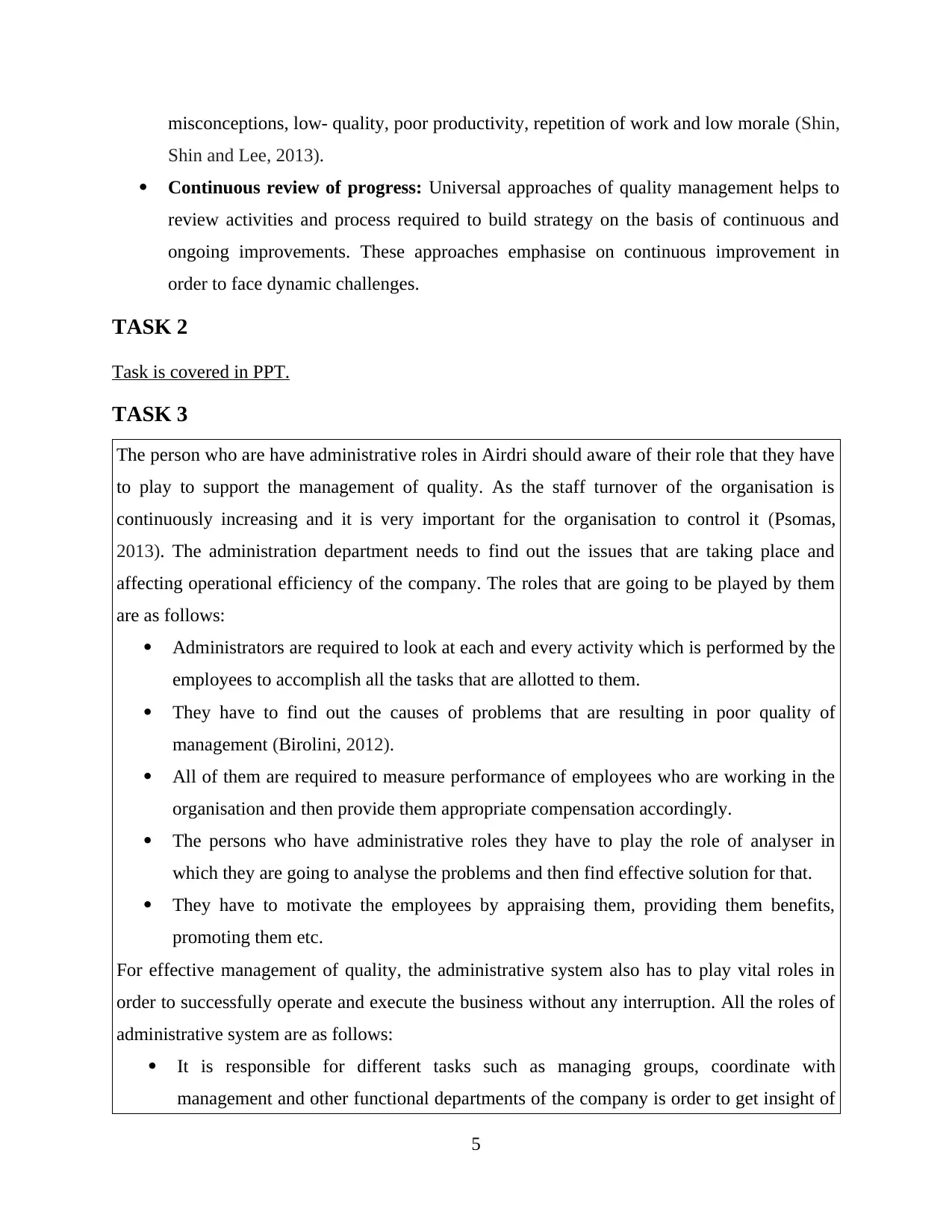
misconceptions, low- quality, poor productivity, repetition of work and low morale (Shin,
Shin and Lee, 2013).
Continuous review of progress: Universal approaches of quality management helps to
review activities and process required to build strategy on the basis of continuous and
ongoing improvements. These approaches emphasise on continuous improvement in
order to face dynamic challenges.
TASK 2
Task is covered in PPT.
TASK 3
The person who are have administrative roles in Airdri should aware of their role that they have
to play to support the management of quality. As the staff turnover of the organisation is
continuously increasing and it is very important for the organisation to control it (Psomas,
2013). The administration department needs to find out the issues that are taking place and
affecting operational efficiency of the company. The roles that are going to be played by them
are as follows:
Administrators are required to look at each and every activity which is performed by the
employees to accomplish all the tasks that are allotted to them.
They have to find out the causes of problems that are resulting in poor quality of
management (Birolini, 2012).
All of them are required to measure performance of employees who are working in the
organisation and then provide them appropriate compensation accordingly.
The persons who have administrative roles they have to play the role of analyser in
which they are going to analyse the problems and then find effective solution for that.
They have to motivate the employees by appraising them, providing them benefits,
promoting them etc.
For effective management of quality, the administrative system also has to play vital roles in
order to successfully operate and execute the business without any interruption. All the roles of
administrative system are as follows:
It is responsible for different tasks such as managing groups, coordinate with
management and other functional departments of the company is order to get insight of
5
Shin and Lee, 2013).
Continuous review of progress: Universal approaches of quality management helps to
review activities and process required to build strategy on the basis of continuous and
ongoing improvements. These approaches emphasise on continuous improvement in
order to face dynamic challenges.
TASK 2
Task is covered in PPT.
TASK 3
The person who are have administrative roles in Airdri should aware of their role that they have
to play to support the management of quality. As the staff turnover of the organisation is
continuously increasing and it is very important for the organisation to control it (Psomas,
2013). The administration department needs to find out the issues that are taking place and
affecting operational efficiency of the company. The roles that are going to be played by them
are as follows:
Administrators are required to look at each and every activity which is performed by the
employees to accomplish all the tasks that are allotted to them.
They have to find out the causes of problems that are resulting in poor quality of
management (Birolini, 2012).
All of them are required to measure performance of employees who are working in the
organisation and then provide them appropriate compensation accordingly.
The persons who have administrative roles they have to play the role of analyser in
which they are going to analyse the problems and then find effective solution for that.
They have to motivate the employees by appraising them, providing them benefits,
promoting them etc.
For effective management of quality, the administrative system also has to play vital roles in
order to successfully operate and execute the business without any interruption. All the roles of
administrative system are as follows:
It is responsible for different tasks such as managing groups, coordinate with
management and other functional departments of the company is order to get insight of
5
Paraphrase This Document
Need a fresh take? Get an instant paraphrase of this document with our AI Paraphraser
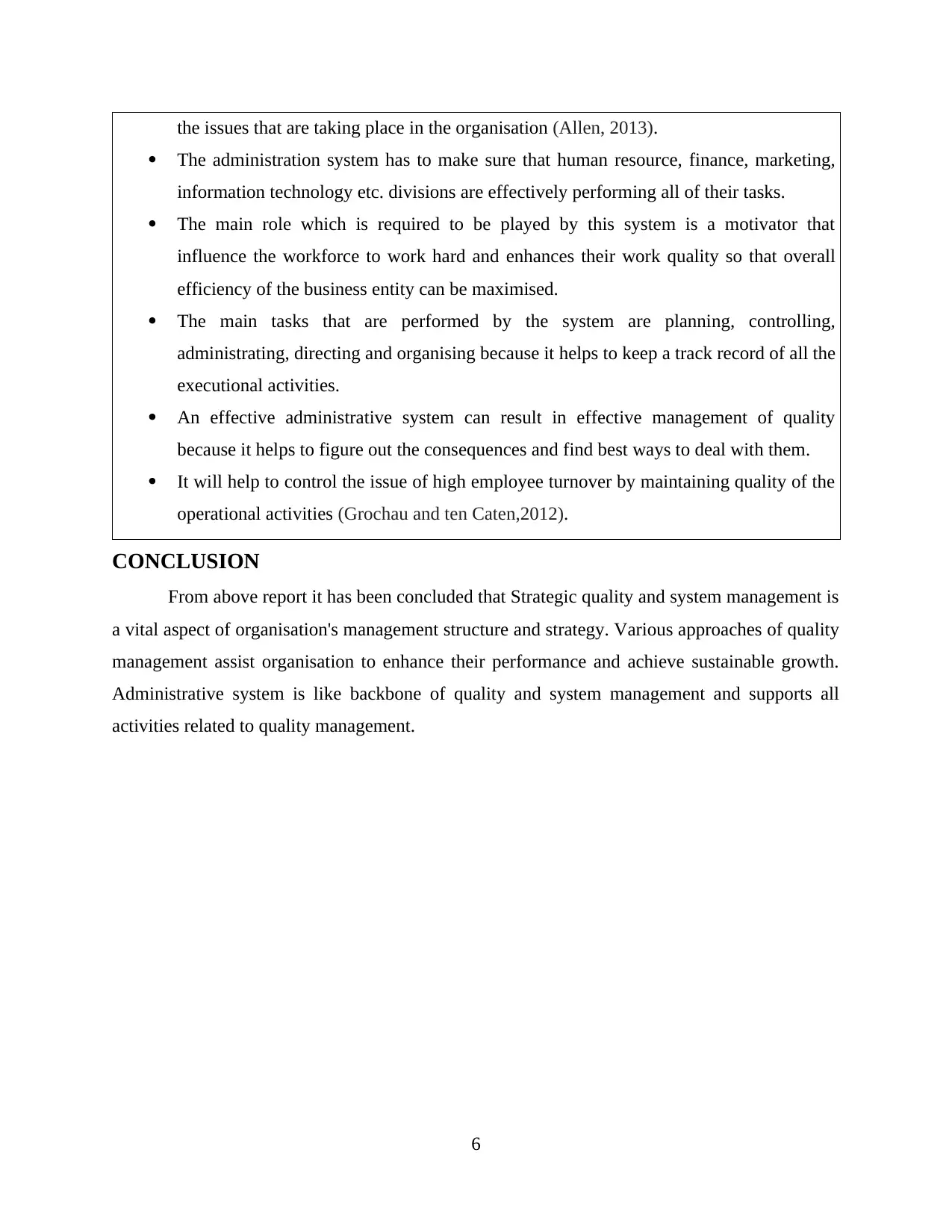
the issues that are taking place in the organisation (Allen, 2013).
The administration system has to make sure that human resource, finance, marketing,
information technology etc. divisions are effectively performing all of their tasks.
The main role which is required to be played by this system is a motivator that
influence the workforce to work hard and enhances their work quality so that overall
efficiency of the business entity can be maximised.
The main tasks that are performed by the system are planning, controlling,
administrating, directing and organising because it helps to keep a track record of all the
executional activities.
An effective administrative system can result in effective management of quality
because it helps to figure out the consequences and find best ways to deal with them.
It will help to control the issue of high employee turnover by maintaining quality of the
operational activities (Grochau and ten Caten,2012).
CONCLUSION
From above report it has been concluded that Strategic quality and system management is
a vital aspect of organisation's management structure and strategy. Various approaches of quality
management assist organisation to enhance their performance and achieve sustainable growth.
Administrative system is like backbone of quality and system management and supports all
activities related to quality management.
6
The administration system has to make sure that human resource, finance, marketing,
information technology etc. divisions are effectively performing all of their tasks.
The main role which is required to be played by this system is a motivator that
influence the workforce to work hard and enhances their work quality so that overall
efficiency of the business entity can be maximised.
The main tasks that are performed by the system are planning, controlling,
administrating, directing and organising because it helps to keep a track record of all the
executional activities.
An effective administrative system can result in effective management of quality
because it helps to figure out the consequences and find best ways to deal with them.
It will help to control the issue of high employee turnover by maintaining quality of the
operational activities (Grochau and ten Caten,2012).
CONCLUSION
From above report it has been concluded that Strategic quality and system management is
a vital aspect of organisation's management structure and strategy. Various approaches of quality
management assist organisation to enhance their performance and achieve sustainable growth.
Administrative system is like backbone of quality and system management and supports all
activities related to quality management.
6
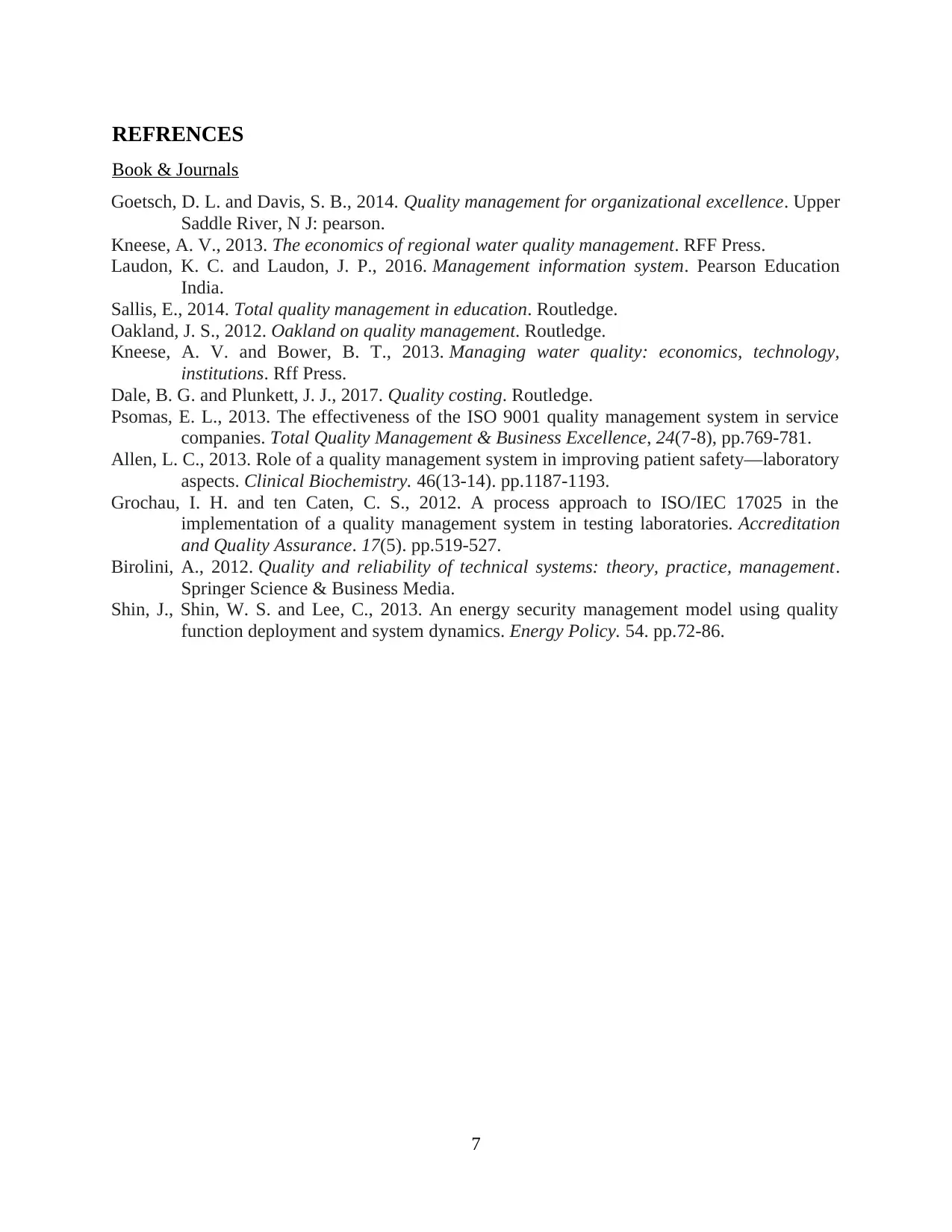
REFRENCES
Book & Journals
Goetsch, D. L. and Davis, S. B., 2014. Quality management for organizational excellence. Upper
Saddle River, N J: pearson.
Kneese, A. V., 2013. The economics of regional water quality management. RFF Press.
Laudon, K. C. and Laudon, J. P., 2016. Management information system. Pearson Education
India.
Sallis, E., 2014. Total quality management in education. Routledge.
Oakland, J. S., 2012. Oakland on quality management. Routledge.
Kneese, A. V. and Bower, B. T., 2013. Managing water quality: economics, technology,
institutions. Rff Press.
Dale, B. G. and Plunkett, J. J., 2017. Quality costing. Routledge.
Psomas, E. L., 2013. The effectiveness of the ISO 9001 quality management system in service
companies. Total Quality Management & Business Excellence, 24(7-8), pp.769-781.
Allen, L. C., 2013. Role of a quality management system in improving patient safety—laboratory
aspects. Clinical Biochemistry. 46(13-14). pp.1187-1193.
Grochau, I. H. and ten Caten, C. S., 2012. A process approach to ISO/IEC 17025 in the
implementation of a quality management system in testing laboratories. Accreditation
and Quality Assurance. 17(5). pp.519-527.
Birolini, A., 2012. Quality and reliability of technical systems: theory, practice, management.
Springer Science & Business Media.
Shin, J., Shin, W. S. and Lee, C., 2013. An energy security management model using quality
function deployment and system dynamics. Energy Policy. 54. pp.72-86.
7
Book & Journals
Goetsch, D. L. and Davis, S. B., 2014. Quality management for organizational excellence. Upper
Saddle River, N J: pearson.
Kneese, A. V., 2013. The economics of regional water quality management. RFF Press.
Laudon, K. C. and Laudon, J. P., 2016. Management information system. Pearson Education
India.
Sallis, E., 2014. Total quality management in education. Routledge.
Oakland, J. S., 2012. Oakland on quality management. Routledge.
Kneese, A. V. and Bower, B. T., 2013. Managing water quality: economics, technology,
institutions. Rff Press.
Dale, B. G. and Plunkett, J. J., 2017. Quality costing. Routledge.
Psomas, E. L., 2013. The effectiveness of the ISO 9001 quality management system in service
companies. Total Quality Management & Business Excellence, 24(7-8), pp.769-781.
Allen, L. C., 2013. Role of a quality management system in improving patient safety—laboratory
aspects. Clinical Biochemistry. 46(13-14). pp.1187-1193.
Grochau, I. H. and ten Caten, C. S., 2012. A process approach to ISO/IEC 17025 in the
implementation of a quality management system in testing laboratories. Accreditation
and Quality Assurance. 17(5). pp.519-527.
Birolini, A., 2012. Quality and reliability of technical systems: theory, practice, management.
Springer Science & Business Media.
Shin, J., Shin, W. S. and Lee, C., 2013. An energy security management model using quality
function deployment and system dynamics. Energy Policy. 54. pp.72-86.
7
1 out of 9
Related Documents
Your All-in-One AI-Powered Toolkit for Academic Success.
+13062052269
info@desklib.com
Available 24*7 on WhatsApp / Email
![[object Object]](/_next/static/media/star-bottom.7253800d.svg)
Unlock your academic potential
© 2024 | Zucol Services PVT LTD | All rights reserved.





